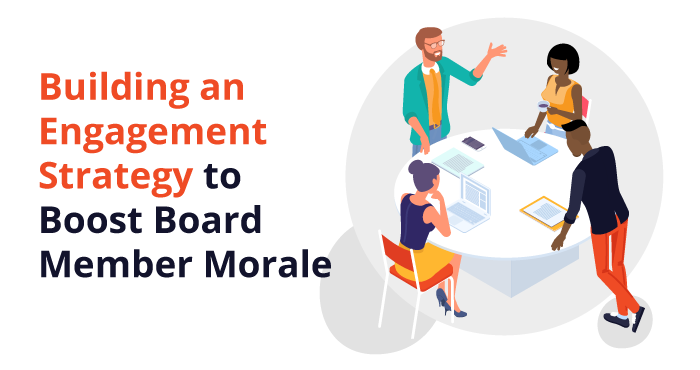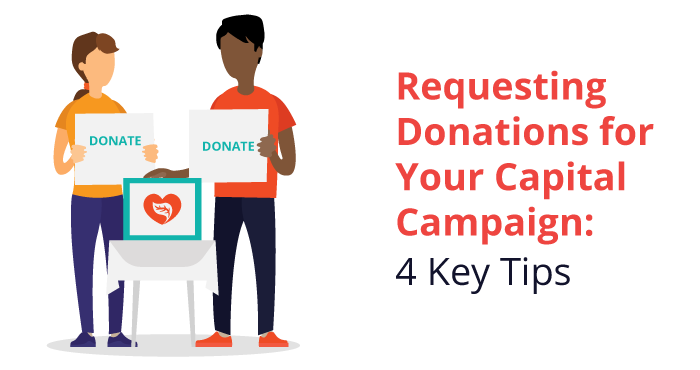Building an Engagement Strategy to Boost Board Member Morale
You want your organization’s board members to be your biggest supporters, but sometimes, you’re so preoccupied that you forget to properly cultivate them into engaged champions of your cause. While this may not pose an immediate threat, the impact of neglecting board members’ experiences can heavily impact their work (and consequently your organization’s success) over time.
If you want board members to succeed and be excited to serve, they’ll need to be thoroughly invested in the mission and their work, which requires some extra effort on your end. This starts the moment they express interest in joining your board and extends throughout the duration of their term. In the end, the extra investment will be well worth it.
Whether you’re new to board leadership or are simply looking to revamp your engagement strategy, you’ve come to the right place! Board engagement requires a unique approach at every organization, and to help you design a thorough engagement strategy, we’ll walk through these key elements:
1. Why Board Engagement Matters
An engaged board is crucial to the health of any organization. Engaged team members are naturally more impactful because they’re willing to devote the necessary time and effort to complete their tasks and exceed expectations.
An engaged team is much more knowledgeable and passionate about the organization. This directly translates into a handful of valuable benefits, including:
- Better governance in the boardroom since everyone will be focused on producing the best outcomes for the organization
- Improved public relations because they’ll naturally spread the word about all the noteworthy work your organization is doing
- More board recruitment opportunities, including an increased pool of participants who have heard great things about serving on your board
Overall, engaging your board members will lead to valuable opportunities for the organization. On the other hand, a disengaged board can work against your vision, making it difficult to make progress.
Nurturing engagement is certainly challenging, but failing to do so can eventually produce insurmountable obstacles for the executive director and the board itself.
2. Ways to Boost Board Engagement
Now that you’re aware of why board engagement matters, it’s time to jump into the fun part: creating a plan for enhancing the board experience.
Bear in mind that it’s not enough to simply increase responsibilities and demand more of your members’ time. These individuals have to want to go above and beyond. To inspire your approach, we’ll walk through a handful of simple yet highly impactful strategies that encourage board members to stay involved.
Provide a meaningful onboarding experience.
Your board of directors is likely comprised of individuals from all different walks of life and various experience levels. They join for all sorts of reasons, whether they’re looking to develop valuable skills, contribute to society, network with other leaders, or socially interact with others during this time of social distancing. Regardless of those reasons, you need to recognize that many of them might have minimal experience with this type of role.
Being in a leadership position may not come naturally for some people, but sufficient guidance can go a long way. Lay the groundwork for your board members with an onboarding experience that sets expectations and helps them understand their roles upfront. For example:
- Assign a board buddy to show new members the ropes, guide them through their first few meetings, and answer any questions they may have. They’ll appreciate having a friendly face in the boardroom.
- Create a welcome packet that condenses down necessary information. Include a summary of your nonprofit’s history, your organization’s bylaws, a list of current board members, and a calendar of upcoming events.
- Walk through each role’s responsibilities to remove any ambiguity. Be sure to communicate that all members should actively advocate for your mission, collaborate with their fellow board members, and come fully prepared to meetings.
Joining a board of directors for the first time can be intimidating. Offering an exceptional onboarding experience can go a long way to break the ice and clarify expectations. This sets the right tone from the start and helps everyone get up to speed quickly so that they can start to make actual progress.
Make the most of your meetings.
Your board members lead busy lives. On top of serving your board, they also balance their work and home lives. So, time in the boardroom must be maximized to the fullest extent possible. Otherwise, they’ll easily become irritated and will mentally clock out before you realize it.
Especially if you’re meeting in a virtual or hybrid format, your officers need to invest plenty of time into keeping board members focused and fully engaged during meetings. Here are a few ways to help board members make the most of their time together:
- Share agendas in advance. A clear and focused board meeting agenda with discussion topics will enable board members to come fully prepared and ready to contribute with thoughtful questions and insights. Consider setting time limits and noting the goal of each item as well, whether that’s to inform, seek advice, or arrive at a decision. That way, you won’t waste time discussing items that were meant to be a quick update.
- Encourage board members to participate. Those who passively listen won’t help you accomplish your goals. Encourage attendees to comment and ask questions as they think of them, instead of waiting until the end. Even if they’re afraid to cause dissonance, all board members’ opinions should be heard. You might also ask if anyone has anything to add after each discussion item, giving them one last opportunity to chime in.
- Limit routine business items. Meetings are the board’s primary opportunity to collaborate and put initiatives into motion. While you certainly need to cover the “have-to’s,” be sure to devote plenty of time to strategic discussions regarding your mission.
Your board chair and administrator will lay the groundwork for your meetings, making sure they hit all the necessary talking points and stay focused. However, it’s up to board members to come prepared and ready to participate in every meeting. Every step you take to make the boardroom more engaging will make preparation and participation much easier on them.
Encourage interaction outside of the boardroom.
Only communicating during meetings will hinder your organization’s growth. When board members connect outside of the boardroom, engagement will thrive. Whether they’re discussing your mission or their personal lives, here are two ways they can stay connected between meetings:
- Retreats: An annual (or semi-annual) retreat gets board members away from the usual meeting space, allowing them to think critically about your organization’s progress. While smaller organizations may only need an afternoon, larger organizations might need two days to cover their bases.
- Social Events: Informal gatherings enable board members to connect on a personal level. Whether in-person or virtual, a more relaxed environment allows them to talk about their personal lives, promoting camaraderie and impacting their chemistry in the boardroom.
However your board members interact, just make sure they stay in touch between meetings. This will go a long way to ensure that they stay connected with your work and keep your organization top of mind.
Thank them for their hard work and dedication.
Don’t let your board members’ hard work go unnoticed. Remember, they’re volunteers; they choose to give their time and can walk away at any point. Pat them on the back for a job well done on a regular basis. Otherwise, they may interpret your silence as a lack of appreciation, leaving a sour taste in their mouths.
Not thanking your board is the easiest way to lose even the most passionate contributors that you worked so hard to recruit.
Among other organizational leaders, the executive director should reach out on a regular basis to personally thank board members for their hard work, whether that’s via phone call, face-to-face, or some other means. Some organizations even shine the spotlight on outstanding board members by featuring them in their newsletter or posting about them on social media. Align with each board member to make sure they would appreciate public recognition first though.
If you’re looking for more ideas – try hosting thank-you events, creating a recognition wall, or giving a small token of appreciation like a gift card or t-shirt. No matter which approach you take, make sure to tailor your strategies and thank them in ways that are meaningful to them.
3. How to Measure Board Engagement
“Engagement” is often an ambiguous term with no truly accurate way to measure it. It usually refers to the relationship between an organization and individuals, be they staff members, donors, volunteers, or board members. It’s often viewed along two axes: (1) “warmth” or sentiment by the individuals toward the organization, and (2) a number of interactions between the organization and individuals.
In other words, there’s no true way to measure board engagement. It varies across organizations and is often based on opinions, rather than hard numbers. However, there are a couple of ways you can track and analyze engagement, broken down into two types:
- Psychological measures. How emotionally connected do individuals feel to your organization? One of the simplest ways to measure psychological engagement is to simply ask. Send a survey, asking members to rate various aspects of their engagement. For instance, ask questions regarding their participation and what they believe can be improved. Take the following survey questions for example:
- On a scale from 1 to 5, what level of preparation and participation do you dedicate to board meetings?
- How well do you understand your role as a board member? Are expectations clear?
- What would you change about the board meetings?
- Could better organization, including online tools, help you manage tasks?
- Do you think you could describe the organization’s mission and accomplishments in an elevator speech?
- What should board members do more of? (e.g. contribute professional talents and resources, tap networks for donations, follow through on assigned tasks)
- What actions should our nonprofit take to keep developing and inspiring our board? (e.g. diversity of board recruits, virtual meeting options, board education opportunities)
- Behavioral measures. Consider the amount of time board members invest in reviewing board materials, communicating via electronic means, asking questions, and completing their tasks. These all serve as latent, non-invasive ways to track behavioral investment.
Having some sort of way to measure board engagement is crucial. Otherwise, you won’t have a reliable way to determine if your strategies are helping, hurting, or making a difference at all. Proactively analyzing engagement means you can adjust your approaches and make sure your efforts are worth it.
Recruiting and onboarding exceptional board members is only the first step in a successful board lifecycle. Successful engagement is a multi-step process—you can’t expect them to stay fully engaged throughout their terms without a bit of motivation.
Remember, board engagement looks different for every organization. No matter how passionate your board members are, your team will need to take extra steps to maintain their involvement and encourage them to stay invested in their work. After all, the last thing you want is a bored board. All that does is waste their valuable time and effort!


